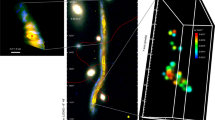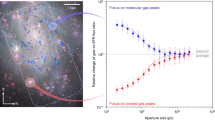Abstract
Massive stars are very rare, but their extreme luminosities make them both the only type of young star we can observe in distant galaxies and the dominant energy sources in the Universe today. They form rarely because efficient radiative cooling keeps most star-forming gas clouds close to isothermal as they collapse, and this favours fragmentation into stars of one solar mass or lower1,2,3. Heating of a cloud by accreting low-mass stars within it can prevent fragmentation and allow formation of massive stars4,5, but the necessary properties for a cloud to form massive stars—and therefore where massive stars form in a galaxy—have not yet been determined. Here we show that only clouds with column densities of at least 1 g cm-2 can avoid fragmentation and form massive stars. This threshold, and the environmental variation of the stellar initial mass function that it implies, naturally explain the characteristic column densities associated with massive star clusters6,7,8,9 and the difference between the radial profiles of Hα and ultraviolet emission in galactic disks10,11. The existence of a threshold also implies that the initial mass function should show detectable variation with environment within the Galaxy, that the characteristic column densities of clusters containing massive stars should vary between galaxies, and that star formation rates in some galactic environments may have been systematically underestimated.
This is a preview of subscription content, access via your institution
Access options
Subscribe to this journal
Receive 51 print issues and online access
$199.00 per year
only $3.90 per issue
Buy this article
- Purchase on Springer Link
- Instant access to full article PDF
Prices may be subject to local taxes which are calculated during checkout



Similar content being viewed by others
References
Larson, R. B. Thermal physics, cloud geometry and the stellar initial mass function. Mon. Not. R. Astron. Soc. 359, 211–222 (2005)
Jappsen, A.-K., Klessen, R. S., Larson, R. B., Li, Y. & Mac Low, M.-M. The stellar mass spectrum from non-isothermal gravoturbulent fragmentation. Astron. Astrophys. 435, 611–623 (2005)
Bonnell, I. A., Clarke, C. J. & Bate, M. R. The Jeans mass and the origin of the knee in the IMF. Mon. Not. R. Astron. Soc. 368, 1296–1300 (2006)
Krumholz, M. R. Radiation feedback and fragmentation in massive protostellar cores. Astrophys. J. 641, L45–L48 (2006)
Krumholz, M. R., Klein, R. I. & McKee, C. F. Radiation-hydrodynamic simulations of collapse and fragmentation in massive protostellar cores. Astrophys. J. 656, 959–979 (2007)
Plume, R., Jaffe, D. T., Evans, N. J., Martin-Pintado, J. & Gomez-Gonzalez, J. Dense gas and star formation: Characteristics of cloud cores associated with water masers. Astrophys. J. 476, 730–749 (1997)
Mueller, K. E., Shirley, Y. L., Evans, N. J. & Jacobson, H. R. The physical conditions for massive star formation: Dust continuum maps and modeling. Astrophys. J. Suppl. Ser. 143, 469–497 (2002)
Shirley, Y. L., Evans, N. J., Young, K. E., Knez, C. & Jaffe, D. T. A CS J = 5 → 4 mapping survey toward high-mass star-forming cores associated with water masers. Astrophys. J. Suppl. Ser. 149, 375–403 (2003)
McKee, C. F. & Tan, J. C. The formation of massive stars from turbulent cores. Astrophys. J. 585, 850–871 (2003)
Martin, C. L. & Kennicutt, R. C. Star formation thresholds in galactic disks. Astrophys. J. 555, 301–321 (2001)
Boissier, S. et al. Radial variation of attenuation and star formation in the largest late-type disks observed with GALEX. Astrophys. J. Suppl. Ser. 173, 524–537 (2007)
Heyer, M. H. & Brunt, C. M. The universality of turbulence in galactic molecular clouds. Astrophys. J. 615, L45–L48 (2004)
Chakrabarti, S. & McKee, C. F. Far-infrared SEDs of embedded protostars and dusty galaxies. I. Theory for spherical sources. Astrophys. J. 631, 792–808 (2005)
Neufeld, D. A., Lepp, S. & Melnick, G. J. Thermal balance in dense molecular clouds: Radiative cooling rates and emission-line luminosities. Astrophys. J. Suppl. Ser. 100, 132–147 (1995)
Young, K. E., Lee, J.-E., Evans, N. J., Goldsmith, P. F. & Doty, S. D. Probing pre-protostellar cores with formaldehyde. Astrophys. J. 614, 252–266 (2004)
Urban, A., Evans, N. J. & Doty, S. D. A parameter study of the dust and gas temperature in a field of young stars. Astrophys. J. (submitted); preprint at 〈http://arXiv.org/abs/0710.3906〉 (2007)
Weingartner, J. C. & Draine, B. T. Dust grain-size distributions and extinction in the Milky Way, Large Magellanic Cloud, and Small Magellanic Cloud. Astrophys. J. 548, 296–309 (2001)
Wu, J. et al. Connecting dense gas tracers of star formation in our galaxy to high-Z star formation. Astrophys. J. 635, L173–L176 (2005)
Chabrier, G. in The Initial Mass Function 50 Years Later (ed. Corbelli, E., Palla, F. & Zinnecker, H.) 41–50 (Springer, Dordrecht, 2005)
Tan, J. C., Krumholz, M. R. & McKee, C. F. Equilibrium star cluster formation. Astrophys. J. 641, L121–L124 (2006)
Krumholz, M. R. & Tan, J. C. Slow star formation in dense gas: Evidence and implications. Astrophys. J. 654, 304–315 (2007)
Krumholz, M. R. & McKee, C. F. A general theory of turbulence-regulated star formation, from spirals to ultraluminous infrared galaxies. Astrophys. J. 630, 250–268 (2005)
Bonnell, I. A., Vine, S. G. & Bate, M. R. Massive star formation: nurture, not nature. Mon. Not. R. Astron. Soc. 349, 735–741 (2004)
Motte, F. et al. The earliest phases of high-mass star formation: a 3 square degree millimeter continuum mapping of Cygnus X. Astron. Astrophys. 476, 1243–1260 (2007)
Braine, J., Ferguson, A. M. N., Bertoldi, F. & Wilson, C. D. The detection of molecular gas in the outskirts of NGC 6946. Astrophys. J. 669, L73–L76 (2007)
Parravano, A., Hollenbach, D. J. & McKee, C. F. Time dependence of the ultraviolet radiation field in the local interstellar medium. Astrophys. J. 584, 797–817 (2003)
Matzner, C. D. & McKee, C. F. Efficiencies of low-mass star and star cluster formation. Astrophys. J. 545, 364–378 (2000)
Huff, E. M. & Stahler, S. W. Star formation in space and time: The Orion Nebula Cluster. Astrophys. J. 644, 355–363 (2006)
Feigelson, E. D. & Townsley, L. K. The diverse stellar populations of the W3 star forming complex. Astrophys. J. 673, 354–362 (2008); preprint at 〈http://arXiv.org/abs/0710.0090〉 (2007)
McKee, C. F. & Tan, J. C. Massive star formation in 100,000 years from turbulent and pressurized molecular clouds. Nature 416, 59–61 (2002)
Acknowledgements
We acknowledge S. Boissier, I. Bonnell, B. Elmegreen, E. Feigelson and C. Martin for discussions. We thank A. Urban, N. Evans and S. Doty for providing a copy of their grain–gas coupling code. This work was supported by NASA through the Hubble Fellowship program and by the NSF. Parts of this work were performed while the authors were in residence at the Kavli Institute for Theoretical Physics at UCSB.
Author information
Authors and Affiliations
Corresponding author
Supplementary information
Supplementary Information
The file contains Supplementary Discussion in which several of the results stated in the main text are derived in more detail and Supplementary Figure 1 with Legend. (PDF 279 kb)
Rights and permissions
About this article
Cite this article
Krumholz, M., McKee, C. A minimum column density of 1 g cm-2 for massive star formation. Nature 451, 1082–1084 (2008). https://doi.org/10.1038/nature06620
Received:
Accepted:
Issue Date:
DOI: https://doi.org/10.1038/nature06620
This article is cited by
-
A comparison of the UV and HI properties of the extended UV (XUV) disk galaxies NGC 2541, NGC 5832 and ESO406-042
Journal of Astrophysics and Astronomy (2021)
-
Discovery of massive star formation quenching by non-thermal effects in the centre of NGC 1097
Nature Astronomy (2017)
-
Can molecular clouds live long?
Astrophysics and Space Science (2014)
-
Role of column density in the formation of stars and black holes
Nature Physics (2010)
Comments
By submitting a comment you agree to abide by our Terms and Community Guidelines. If you find something abusive or that does not comply with our terms or guidelines please flag it as inappropriate.



